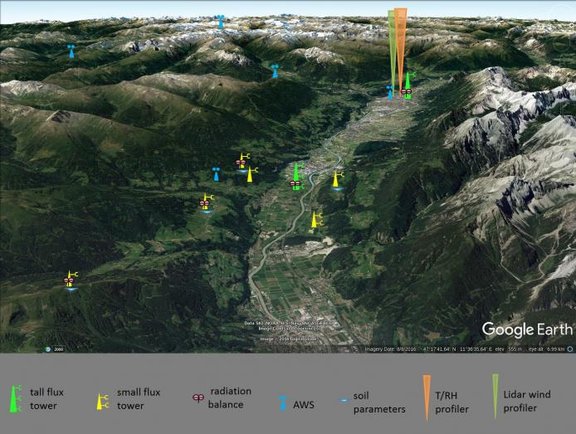Innsbruck Box (i-Box)

Innsbruck Box (or i-Box for short) is a test bed for studying boundary layer processes in highly complex terrain. Designed to be a long-term "reference box" for studying the characteristics of turbulence structure and exchange processes in truly complex topography, i-Box represents an integrated approach combining three-dimensional long-term turbulence observations with high-resolution numerical modeling. Turbulence structure plays an important role in exchange processes of momentum, mass, and energy between the earth’s surface and the atmosphere. These processes are crucial for, e.g., numerical weather forecasts, but are not yet fully understood, particularly not in complex topography. The goal of the project is to form a complete and physically based description of turbulence characteristics in complex terrain.
Both the observational data and the results from numerical modeling (virtual i-Box) will allow for improvements in process understanding, once the numerical models are capable of truly reproducing the observations. Numerical modeling will also be used to fill data gaps in areas where no measurements are possible or the current measurement techniques are inadequate, whereas idealized numerical simulations will be used for testing the hypothesis and sensitivities.
i-Box observational stations are located in the Inn Valley (Figure 1), an approximately northeast-southwest oriented valley in western Austria, characterized by very complex terrain with steep slopes, flat foothills, numerous side valleys, variable land use characteristics, etc. Instead of a single measurement column or a cross-valley transect, the observational sites form a three-dimensional ‘box'. The locations of the core sites (six turbulence stations) were chosen to represent different topographic features in order to secure the universality of the obtained results. The sites are thus located at the valley bottom, on slopes with different angles and orientation, and at a mountain top. Additional measurements include vertical profiles of temperature, humidity, and wind from remote-sensing instruments located at the roof of a university building in Innsbruck.
Project
Project WIKI:
https://wiki.uibk.ac.at/display/IBOX/i-Box+Home
TV-comment Tirol TV:
https://www.uibk.ac.at/newsroom/meteorologie-forschen-an-der-grenzschicht.html.de
Project overview in BAMS:
http://journals.ametsoc.org/doi/abs/10.1175/BAMS-D-15-00246.1
Project Leader:
Members:
Goger Brigitta
Lehner Manuela
Obleitner Friedrich
Sfyri-Janssen Eleni
Stiperski Ivana
Funding Agencies:
Base funding from the PI's start-up grant
Austrian Science Fund (FWF)
MeteoSwiss
HRSM (Hochschulraum Strukturmittel)
Project Duration:
01/08/2011 to 31/01/2025
